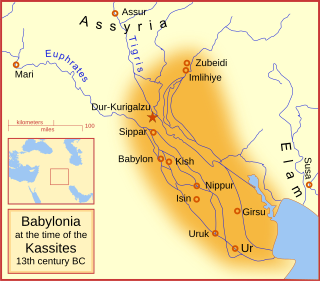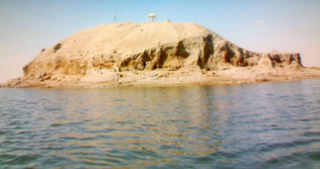| Millennium |
|---|
| 2nd millennium BC |
| Centuries |
| Decades |
| Years |
|
| Categories |
The 1710s BC was a decade lasting from January 1, 1719 BC to December 31, 1710 BC.
| Millennium |
|---|
| 2nd millennium BC |
| Centuries |
| Decades |
| Years |
|
| Categories |
The 1710s BC was a decade lasting from January 1, 1719 BC to December 31, 1710 BC.
The 1720s BC was a decade lasting from January 1, 1729 BC to December 31, 1720 BC.
The 1730s BC was a decade lasting from January 1, 1739 BC to December 31, 1730 BC.
The 1740s BC was a decade lasting from January 1, 1749 BC to December 31, 1740 BC.

The Kassites were people of the ancient Near East, who controlled Babylonia after the fall of the Old Babylonian Empire c. 1531 BC and until c. 1155 BC.

Samsu-iluna was the seventh king of the founding Amorite dynasty of Babylon, ruling from 1750 BC to 1712 BC, or from 1686 to 1648 BC. He was the son and successor of Hammurabi by an unknown mother. His reign was marked by the violent uprisings of areas conquered by his father and the abandonment of several important cities.
Samsu-ditāna, inscribed phonetically in cuneiform sa-am-su-di-ta-na in the seals of his servants, the 11th and last king of the Amorite or First Dynasty of Babylon, reigned for 31 years, 1625 – 1595 BC or 1562 – 1531 BC. His reign is best known for its demise with the sudden fall of Babylon at the hands of the Hittites.
Pitḫana (Pythanas) was a Bronze Age king, during the 18th century BC, of the Anatolian city of Kuššara, and a forerunner of the later Hittite dynasty.
Abī-Ešuḫ was the 8th king of the 1st Dynasty of Babylon and reigned for 28 years from c. 1648–1620 BC or 1711–1684 BC. He was preceded by Samsu-iluna, who was his father.
The 1750s BC was a decade lasting from January 1, 1759 BC to December 31, 1750 BC.
Amat-Mamu, fl. ca. 1750 BC, Sippar in ancient Babylonia, was a scribe whose existence is known from the cuneiform tablets on which she wrote.

Sumerian literature constitutes the earliest known corpus of recorded literature, including the religious writings and other traditional stories maintained by the Sumerian civilization and largely preserved by the later Akkadian and Babylonian empires. These records were written in the Sumerian language in the 18th and 17th centuries BC during the Middle Bronze Age.
Khafajah or Khafaje, ancient Tutub, is an archaeological site in Diyala Governorate, Iraq 7 miles (11 km) east of Baghdad. Khafajah lies on the Diyala River, a tributary of the Tigris. Occupied from the Uruk and Jemdet Nasr periods through the end of the Old Babylonian Empire, it was under the control of the Akkadian Empire and then the Third Dynasty of Ur in the 3rd millennium BC. It then became part of the empire of the city-state of Eshnunna lying 12 miles (19 km) southwest of that city, about 5 miles (8.0 km) from the ancient city of Shaduppum, and near Tell Ishchali, both which Eshnunna also controlled. It then fell to Babylonia before falling into disuse.
Haradum (modern Khirbit ed-Diniye, in Al Anbar Governorate Iraq, was an ancient Near East city on the middle Euphrates about 90 kilometers southeast of Mari. It was part of the ancient region of Suhum. The name of the town meant "the place where one stands watch".

The First Sealand dynasty (URU.KÙKI), or the 2nd Dynasty of Babylon, very speculatively c. 1732–1460 BC, is an enigmatic series of kings attested to primarily in laconic references in the king lists A and B, and as contemporaries recorded on the Assyrian Synchronistic king list A.117. Initially it was named the "Dynasty of the Country of the Sea" with Sealand later becoming customary. The dynasty, which had broken free of the short lived, and by this time crumbling Old Babylonian Empire, was named for the province in the far south of Mesopotamia, a swampy region bereft of large settlements which gradually expanded southwards with the silting up of the mouths of the Tigris and Euphrates rivers. Sealand pottery has been found at Girsu, Uruk, and Lagash but in no site north of that. The later kings bore pseudo-Sumerian names and harked back to the glory days of the dynasty of Isin. The third king of the dynasty was even named for the ultimate king of the dynasty of Isin, Damiq-ilišu. Despite these cultural motifs, the population predominantly bore Akkadian names and wrote and spoke in the Akkadian language. There is circumstantial evidence that their rule extended at least briefly to Babylon itself. In later times, a Sealand province of the Neo-Babylonian Empire also existed.
The early Kassite rulers are the sequence of eight, or possibly nine, names which appear on the Babylonian and Assyrian King Lists purporting to represent the first or ancestral monarchs of the dynasty that was to become the Kassite or 3rd Dynasty of Babylon which governed for 576 years, 9 months, 36 kings, according to the King List A. In all probability the dynasty ruled Babylon for around 350 years.
Apum was an ancient Amorite kingdom located in the upper Khabur valley, modern northeastern Syria. It was involved in the political and military struggle that dominated the first half of the 18th century BC and led to the establishment of the Babylonian Empire. Apum was incorporated into Babylon in 1728 BC and disappeared from the records.

Tell Taban is an archaeological site in north-eastern Syria in the Al-Hasakah Governorate. It is the site of the ancient city of Ṭābetu.

The Chronicle of Early Kings, named ABC 20 in Grayson’s Assyrian and Babylonian Chronicles and CM 40 in Glassner’s Chroniques mésopotamiennes is a Babylonian chronicle preserved on two tablets: tablet A is well preserved whereas tablet B is broken and the text is fragmentary. The text is episodic in character, and seems to have been composed from linking together the apodoses of omen literature, excerpts of the Weidner Chronicle and kings year-names. The Chronicle begins with events from the late third-millennium reign of Sargon of Akkad and ends, where the tablet is broken away, with the reign of Agum III, c.a 1500 BC.
Rim-Sîn II ruled the ancient Near East city-state of Larsa from 1678 BC to 1674 BC. Rim-Sin II was a contemporary of Samsu-iluna of Babylon.